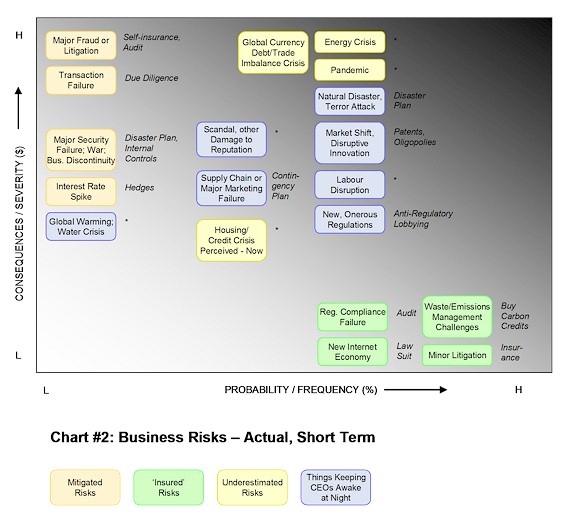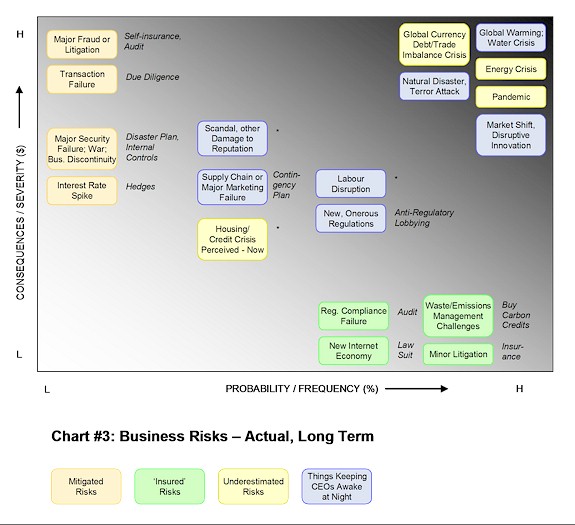 Businesses are preoccupied with risks. Their managers believe they should be able to mitigate them, or at least be prepared for them. But they don’t understand the nature of complexity, and that complex events that pose risks to organizations cannot be analyzed into cause-and-effect, and cannot be accurately predicted, and therefore cannot be planned for, prevented, controlled or mitigated. The only thing a business can do is be resilient enough to cope with them if and when they occur. Business managers likewise are preoccupied with the short term. As a result they don’t concern themselves with risks that they perceive as longer-term, or risks whose probability of occurrence they underestimate out of ignorance. What is a business risk? Something that has a potential negative impact on the organization’s performance or sustainability (its ability to continue to operate and meet its objectives indefinitely). Risk is the product of (a) the probability or frequency of an adverse event occurring and (b) the severity of consequences (financial or otherwise) if it does occur. On the charts in this article, high risks are those in the upper right corner. Risk management is the awareness, preparedness and mitigation actions an organization takes to minimize the consequences of organizational risks. The charts above and below each display 30 major types of organizational risk.
So if you’re an investor, what should you make of this? My suggestion is that you do your own assessment of risks facing the companies you are thinking of investing in, and then read the Management Discussion and Analysis to see (a) whether what management is doing to address those risks is appropriate, and (b) to the extent there is little management can do, how exposed the company is to risks beyond its control. And if you’re an activist, how can you use corporate management’s risk preoccupation to bring about social and environmental reform? This is tougher, because you need to discover what most companies don’t disclose: the social and environmentally irresponsible activities they engage in: the pollution and waste their operations produce, their propensity to use outsourcing, offshoring, union-busting and unsafe labour practices to keep costs down, the extent to which they intimidate employees and customers seeking redress for corporate misdeeds, their lobbying activities that are in the company’s interest but against the public interest, and the exploitation of foreign labour and underpriced foreign resources.. Most of these activities, while unethical, are not illegal. What’s worse, because they externalize costs (transfer them from the corporation to others) these actions contribute to the Tragedy of the Commons — and therefore exacerbate many of the external risks on these charts (global warming, energy and water shortages etc.) — risks that then affect everyone on the planet. Because these activities are not illegal, and many of them increase short-term profits, the activist’s only recourse is to educate the public and embarrass the company into behaving more ethically. They will do this if public outrage reaches the level that the risk of damage to its reputation (one of the risks in blue on these charts) exceeds the financial rewards of unethical behaviour. Many pension funds, government investors and other private equity funds now consider corporate ethics in making investment decisions, and a combination of customer and investor loathing for a corporation’s behaviour can be a powerful market force, and a motivator to a company to clean up its act. As consumers and investors, we have more power to influence corporate activity than we might think. But it’s very difficult and expensive to get compelling, reliable evidence of corporate misdeeds, in an age when the mainstream media have largely given up on investigative reporting, and when giant corporations have deep pockets and armies of lawyers to buy off or threatenwhistleblowers, activists and investigative journalists. But at least we can know what motivates management thinking, and therefore what we’re up against. Categories: Consumer Power and Activism
|
Navigation
Collapsniks
Albert Bates (US)
Andrew Nikiforuk (CA)
Brutus (US)
Carolyn Baker (US)*
Catherine Ingram (US)
Chris Hedges (US)
Dahr Jamail (US)
Dean Spillane-Walker (US)*
Derrick Jensen (US)
Dougald & Paul (IE/SE)*
Erik Michaels (US)
Gail Tverberg (US)
Guy McPherson (US)
Honest Sorcerer
Janaia & Robin (US)*
Jem Bendell (UK)
Mari Werner
Michael Dowd (US)*
Nate Hagens (US)
Paul Heft (US)*
Post Carbon Inst. (US)
Resilience (US)
Richard Heinberg (US)
Robert Jensen (US)
Roy Scranton (US)
Sam Mitchell (US)
Tim Morgan (UK)
Tim Watkins (UK)
Umair Haque (UK)
William Rees (CA)
XrayMike (AU)
Radical Non-Duality
Tony Parsons
Jim Newman
Tim Cliss
Andreas Müller
Kenneth Madden
Emerson Lim
Nancy Neithercut
Rosemarijn Roes
Frank McCaughey
Clare Cherikoff
Ere Parek, Izzy Cloke, Zabi AmaniEssential Reading
Archive by Category
My Bio, Contact Info, Signature Posts
About the Author (2023)
My Circles
E-mail me
--- My Best 200 Posts, 2003-22 by category, from newest to oldest ---
Collapse Watch:
Hope — On the Balance of Probabilities
The Caste War for the Dregs
Recuperation, Accommodation, Resilience
How Do We Teach the Critical Skills
Collapse Not Apocalypse
Effective Activism
'Making Sense of the World' Reading List
Notes From the Rising Dark
What is Exponential Decay
Collapse: Slowly Then Suddenly
Slouching Towards Bethlehem
Making Sense of Who We Are
What Would Net-Zero Emissions Look Like?
Post Collapse with Michael Dowd (video)
Why Economic Collapse Will Precede Climate Collapse
Being Adaptable: A Reminder List
A Culture of Fear
What Will It Take?
A Future Without Us
Dean Walker Interview (video)
The Mushroom at the End of the World
What Would It Take To Live Sustainably?
The New Political Map (Poster)
Beyond Belief
Complexity and Collapse
Requiem for a Species
Civilization Disease
What a Desolated Earth Looks Like
If We Had a Better Story...
Giving Up on Environmentalism
The Hard Part is Finding People Who Care
Going Vegan
The Dark & Gathering Sameness of the World
The End of Philosophy
A Short History of Progress
The Boiling Frog
Our Culture / Ourselves:
A CoVid-19 Recap
What It Means to be Human
A Culture Built on Wrong Models
Understanding Conservatives
Our Unique Capacity for Hatred
Not Meant to Govern Each Other
The Humanist Trap
Credulous
Amazing What People Get Used To
My Reluctant Misanthropy
The Dawn of Everything
Species Shame
Why Misinformation Doesn't Work
The Lab-Leak Hypothesis
The Right to Die
CoVid-19: Go for Zero
Pollard's Laws
On Caste
The Process of Self-Organization
The Tragic Spread of Misinformation
A Better Way to Work
The Needs of the Moment
Ask Yourself This
What to Believe Now?
Rogue Primate
Conversation & Silence
The Language of Our Eyes
True Story
May I Ask a Question?
Cultural Acedia: When We Can No Longer Care
Useless Advice
Several Short Sentences About Learning
Why I Don't Want to Hear Your Story
A Harvest of Myths
The Qualities of a Great Story
The Trouble With Stories
A Model of Identity & Community
Not Ready to Do What's Needed
A Culture of Dependence
So What's Next
Ten Things to Do When You're Feeling Hopeless
No Use to the World Broken
Living in Another World
Does Language Restrict What We Can Think?
The Value of Conversation Manifesto Nobody Knows Anything
If I Only Had 37 Days
The Only Life We Know
A Long Way Down
No Noble Savages
Figments of Reality
Too Far Ahead
Learning From Nature
The Rogue Animal
How the World Really Works:
Making Sense of Scents
An Age of Wonder
The Truth About Ukraine
Navigating Complexity
The Supply Chain Problem
The Promise of Dialogue
Too Dumb to Take Care of Ourselves
Extinction Capitalism
Homeless
Republicans Slide Into Fascism
All the Things I Was Wrong About
Several Short Sentences About Sharks
How Change Happens
What's the Best Possible Outcome?
The Perpetual Growth Machine
We Make Zero
How Long We've Been Around (graphic)
If You Wanted to Sabotage the Elections
Collective Intelligence & Complexity
Ten Things I Wish I'd Learned Earlier
The Problem With Systems
Against Hope (Video)
The Admission of Necessary Ignorance
Several Short Sentences About Jellyfish
Loren Eiseley, in Verse
A Synopsis of 'Finding the Sweet Spot'
Learning from Indigenous Cultures
The Gift Economy
The Job of the Media
The Wal-Mart Dilemma
The Illusion of the Separate Self, and Free Will:
No Free Will, No Freedom
The Other Side of 'No Me'
This Body Takes Me For a Walk
The Only One Who Really Knew Me
No Free Will — Fightin' Words
The Paradox of the Self
A Radical Non-Duality FAQ
What We Think We Know
Bark Bark Bark Bark Bark Bark Bark
Healing From Ourselves
The Entanglement Hypothesis
Nothing Needs to Happen
Nothing to Say About This
What I Wanted to Believe
A Continuous Reassemblage of Meaning
No Choice But to Misbehave
What's Apparently Happening
A Different Kind of Animal
Happy Now?
This Creature
Did Early Humans Have Selves?
Nothing On Offer Here
Even Simpler and More Hopeless Than That
Glimpses
How Our Bodies Sense the World
Fragments
What Happens in Vagus
We Have No Choice
Never Comfortable in the Skin of Self
Letting Go of the Story of Me
All There Is, Is This
A Theory of No Mind
Creative Works:
Mindful Wanderings (Reflections) (Archive)
A Prayer to No One
Frogs' Hollow (Short Story)
We Do What We Do (Poem)
Negative Assertions (Poem)
Reminder (Short Story)
A Canadian Sorry (Satire)
Under No Illusions (Short Story)
The Ever-Stranger (Poem)
The Fortune Teller (Short Story)
Non-Duality Dude (Play)
Your Self: An Owner's Manual (Satire)
All the Things I Thought I Knew (Short Story)
On the Shoulders of Giants (Short Story)
Improv (Poem)
Calling the Cage Freedom (Short Story)
Rune (Poem)
Only This (Poem)
The Other Extinction (Short Story)
Invisible (Poem)
Disruption (Short Story)
A Thought-Less Experiment (Poem)
Speaking Grosbeak (Short Story)
The Only Way There (Short Story)
The Wild Man (Short Story)
Flywheel (Short Story)
The Opposite of Presence (Satire)
How to Make Love Last (Poem)
The Horses' Bodies (Poem)
Enough (Lament)
Distracted (Short Story)
Worse, Still (Poem)
Conjurer (Satire)
A Conversation (Short Story)
Farewell to Albion (Poem)
My Other Sites







i really like you’re topic..it has a lot information to use..it shares a lot of ideas and tips to get..this one is really recommending..can you check our site if u don’t mind..thanks..keep it up..
thanks to your topic., you point out the problems.